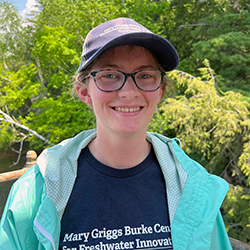It was day two in Isle Royale National Park, and the GPS wouldn’t cooperate, leaving us disoriented in the wilderness. Just keep truckin’ quickly became our motto as we tripped over logs and got whipped by twigs, hoping the coordinates in the GPS brought us back to the Greenstone Ridge Trail after our visit to Sargent Lake. We had already spent hours bushwhacking to the lake. Getting lost was just the cherry on top of a hard day.

Why were we willingly going off trail into the isolated and rugged wilderness? For science, of course! Elisabeth Westgard ’23 and I were on Isle Royale on behalf of the Mary Griggs Burke Center for Freshwater Innovation to do our part for the national Dragonfly Mercury Project.
The project, which measures mercury concentrations in dragonfly larvae from national park units across the country, is a collaboration between the National Park Service and the United States Geological Survey to better understand global mercury risks and the effectiveness of mercury-reduction policies. Dragonfly larva are indicators of toxins within the environment, and by using national park units, experts can understand potential risks from mercury in even the most pristine and remote places in the US. Over one hundred park units are sampled each year, which makes the project perfect for a citizen-science framework. Northland students have been busy collecting dragonfly larvae from the Apostle Islands National Lakeshore, the Grand Portage National Monument, Isle Royale National Park, and the Saint Croix National Scenic Riverway since 2012.
This summer, Elisabeth and I backpacked for nine days through Grand Portage and Isle Royale searching for larval dragonflies. Each day was exhausting, but we saw lots of wildlife and beautiful sights along the way. As Elisabeth said, “The trip was tough in the moment but extraordinary after the fact.”
After we finally emerged from the woods surrounding Sargent Lake, we spent the final three-mile hike reflecting on the day. It was hard: we spent twelve frustrating hours hiking and bushwhacking for a dozen little larval dragonflies—and Elisabeth counted five leeches on her legs! Despite the challenges, the island glowed in the sunset as we descended into camp, and we were proud to do our part to help federal scientists understand health risks associated with mercury in some of the most remote parts of the country.
Kristen Vensland ’24 is a natural resources major who will become lead larva collector next year after Elisabeth graduates. She has enjoyed learning all of the ins and outs of the Burke Center over the past two summers. After graduation, she is looking forward to staying in Ashland.




